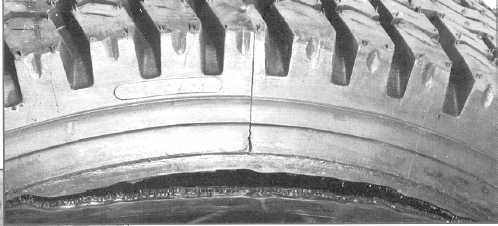TM 9-2610-200-14
2-111
VISUAL GUIDE FOR INSPECTION AND CLASSIFICATION OF TIRES
(Con't)
2-48. SIDEWALL AREA CONDITIONS (Con't).
h. Circumferential Fatigue Rupture (Zipper). This is a phenomenon which has become more
frequent with radial tires in recent years. It's caused by cord fatigue, and results in the cords breaking (or
unzipping), suddenly, in a circumferential direction. The main reason for this type of tire failure is
operating in severe underinflation. The early signs of this type of failure are very subtle ripples, in a
circumferential pattern in the upper sidewall area. These ripples are very hard to detect. An experienced
inspector may find these ripples by hold a light off-set, and gently feeling the upper sidewall with a hand.
Tires with the early stages of zipper fatigue have been known to unzip, with explosive force, during
inflation. That is why it is very important to use a tire safety cage, and to keep personnel out of the
trajectory (front or back of either sidewall) during inflation. This tire or any tire with the early signs of
zipper fatigue would be classified CRC H.
2-49. TREAD CROWN AREA CONDITIONS.
a. Burned Tire Tread. This tire tread was damaged by
fire, but not badly enough to require repair. Note that the
damage is small and does not penetrate very deeply. The tire
is still serviceable and should be returned to the user. Correct
classification is CRC B.



